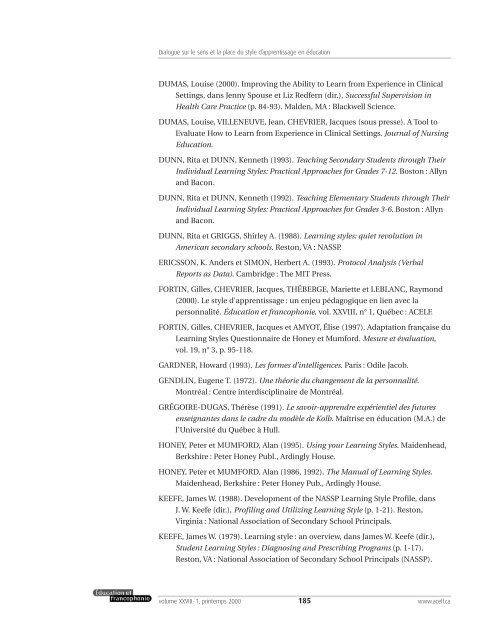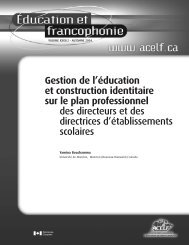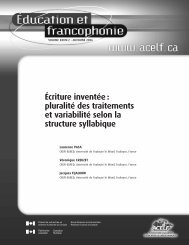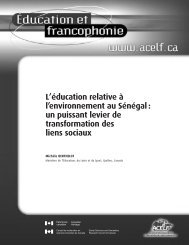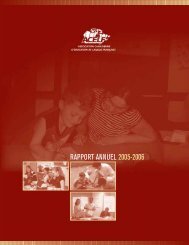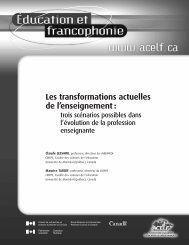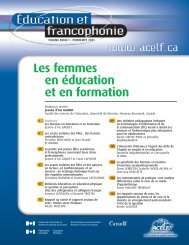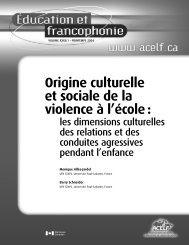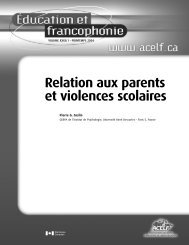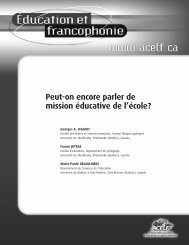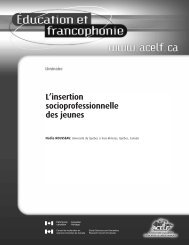Dialogue sur le sens et la place du <strong>style</strong> d’apprentissage en éducationde formation. Pour en arriver à participer à cette construction inscrite « dans cettedouble tension » « entre le soi personnel et le soi social » (Chevrier et al., 2000), la formationa avantage non seulement à être à l’affût de la recherche portant sur un objetcomme celui du <strong>style</strong> d’apprentissage, mais à en être l’instigatrice.Références bibliographiquesBARTH, Britt-Mari (1996). Construire son savoir, dans Étienne Bourgeois (dir.),L’adulte en formation (p. 19-36). Paris : De Boeck & Larcier.BOYATZIS, Richard E. et KOLB, David A. (1991). Assessing Individuality in <strong>Le</strong>arning :The <strong>Le</strong>arning Skills Profile. Educational Psychology, vol. 11, n os 3-4, p. 279-295.BROOKS-HARRIS, Jeff E. et STOCK-WARD, Susan R. (1999). Workshops : Designingand Facilitating Experiential <strong>Le</strong>arning. California : Sage.BROWN, Susan C., KYSILLA, Marcella L. et WARNER, Maureen J. (1996). ApplyingConstructivist Theory to Multicultural Education Content, dans MichaelKompf, W. Richard Bond, Don Dworet et R. Terrance Boak (dir.), ChangingResearch and Practice: Teachers’ Professionalism, Identities and Knowledge(p. 167-174). Londres : Falmer Press.BÜCHEL, Fredi P. (2000). Style d’apprentissage et théorie métacognitive : unecomparaison des concepts théoriques et de l’application didactique.Éducation et francophonie, vol. XXVIII, n° 1, Québec : ACELF.BÜCHEL, Fredi P. (1995). Découvrez vos capacités, réalisez vos possibilités, planifiezvotre démarche, soyez créatifs. DELF : Un programme d’apprentissage pouradolescents et adulte. Russin/Ge : Centre d’éducation cognitive.CHEVRIER, J., FORTIN, G., THÉBERGE, M. et LEBLANC, R. (2000). La constructiondu <strong>style</strong> d’apprentissage. Éducation et francophonie, vol. XXVIII, n° 1, Québec :ACELF.CHEVRIER, Jacques et CHARBONNEAU, Benoît (à paraître). <strong>Le</strong> savoir-apprendreexpérientiel dans le contexte du modèle de Kolb. Revue des sciences del’éducation.CRAHAY, Marcel (1999). Psychologie de l’éducation. Paris : Presses universitairesde France.DUMAS, Louise (1995). Élaboration et validation d’un instrument d’évaluationformative de la démarche du savoir-apprendre expérientiel de l’infirmièreétudianteen stage clinique. Thèse de doctorat en éducation présentée àl’Université du Québec à Montréal.volume XXVIII : 1, printemps 2000184www.<strong>acelf</strong>.ca
Dialogue sur le sens et la place du <strong>style</strong> d’apprentissage en éducationDUMAS, Louise (2000). Improving the Ability to <strong>Le</strong>arn from Experience in ClinicalSettings, dans Jenny Spouse et Liz Redfern (dir.), Successful Supervision inHealth Care Practice (p. 84-93). Malden, MA : Blackwell Science.DUMAS, Louise, VILLENEUVE, Jean, CHEVRIER, Jacques (sous presse). A Tool toEvaluate How to <strong>Le</strong>arn from Experience in Clinical Settings. Journal of NursingEducation.DUNN, Rita et DUNN, Kenneth (1993). Teaching Secondary Students through TheirIndividual <strong>Le</strong>arning Styles: Practical Approaches for Grades 7-12. Boston : Allynand Bacon.DUNN, Rita et DUNN, Kenneth (1992). Teaching Elementary Students through TheirIndividual <strong>Le</strong>arning Styles: Practical Approaches for Grades 3-6. Boston : Allynand Bacon.DUNN, Rita et GRIGGS, Shirley A. (1988). <strong>Le</strong>arning <strong>style</strong>s: quiet revolution inAmerican secondary schools. Reston, VA : NASSP.ERICSSON, K. Anders et SIMON, Herbert A. (1993). Protocol Analysis (VerbalReports as Data). Cambridge : The MIT Press.FORTIN, Gilles, CHEVRIER, Jacques, THÉBERGE, Mariette et LEBLANC, Raymond(2000). <strong>Le</strong> <strong>style</strong> d’apprentissage : un enjeu pédagogique en lien avec lapersonnalité. Éducation et francophonie, vol. XXVIII, n° 1, Québec : ACELF.FORTIN, Gilles, CHEVRIER, Jacques et AMYOT, Élise (1997). Adaptation française du<strong>Le</strong>arning Styles Questionnaire de Honey et Mumford. Mesure et évaluation,vol. 19, n° 3, p. 95-118.GARDNER, Howard (1993). <strong>Le</strong>s formes d’intelligences. Paris : Odile Jacob.GENDLIN, Eugene T. (1972). Une théorie du changement de la personnalité.Montréal : Centre interdisciplinaire de Montréal.GRÉGOIRE-DUGAS, Thérèse (1991). <strong>Le</strong> savoir-apprendre expérientiel des futuresenseignantes dans le cadre du modèle de Kolb. Maîtrise en éducation (M.A.) del’Université du Québec à Hull.HONEY, Peter et MUMFORD, Alan (1995). Using your <strong>Le</strong>arning Styles. Maidenhead,Berkshire : Peter Honey Publ., Ardingly House.HONEY, Peter et MUMFORD, Alan (1986, 1992). The Manual of <strong>Le</strong>arning Styles.Maidenhead, Berkshire : Peter Honey Pub., Ardingly House.KEEFE, James W. (1988). Development of the NASSP <strong>Le</strong>arning Style Profile, dansJ. W. Keefe (dir.), Profiling and Utilizing <strong>Le</strong>arning Style (p. 1-21). Reston,Virginia : National Association of Secondary School Principals.KEEFE, James W. (1979). <strong>Le</strong>arning <strong>style</strong> : an overview, dans James W. Keefe (dir.),Student <strong>Le</strong>arning Styles : Diagnosing and Prescribing Programs (p. 1-17).Reston, VA : National Association of Secondary School Principals (NASSP).volume XXVIII : 1, printemps 2000185www.<strong>acelf</strong>.ca
- Page 1:
VOLUME XXVIII:1 - PRINTEMPS 2000Le
- Page 4 and 5:
Le style d’apprentissagesage renv
- Page 6 and 7:
Problématique de la nature du styl
- Page 8 and 9:
Problématique de la nature du styl
- Page 10 and 11:
Problématique de la nature du styl
- Page 12 and 13:
Problématique de la nature du styl
- Page 14 and 15:
Problématique de la nature du styl
- Page 16 and 17:
Problématique de la nature du styl
- Page 18 and 19:
Problématique de la nature du styl
- Page 20 and 21:
Problématique de la nature du styl
- Page 22 and 23:
Le style d’apprentissage :une per
- Page 24 and 25:
Le style d’apprentissage : une pe
- Page 26 and 27:
Le style d’apprentissage : une pe
- Page 28 and 29:
Le style d’apprentissage : une pe
- Page 30 and 31:
Le style d’apprentissage : une pe
- Page 32 and 33:
Le style d’apprentissage : une pe
- Page 34 and 35:
Le style d’apprentissage : une pe
- Page 36 and 37:
Le style d’apprentissage : une pe
- Page 38 and 39:
Le style d’apprentissage : une pe
- Page 40 and 41:
Le style d’apprentissage : une pe
- Page 42 and 43:
Le style d’apprentissage : une pe
- Page 44 and 45:
Le style d’apprentissage : une pe
- Page 46 and 47:
Le style d’apprentissage : une pe
- Page 48 and 49:
Le style d’apprentissage : une pe
- Page 50 and 51:
La construction du style d’appren
- Page 52 and 53:
La construction du style d’appren
- Page 54 and 55:
La construction du style d’appren
- Page 56 and 57:
La construction du style d’appren
- Page 58 and 59:
La construction du style d’appren
- Page 60 and 61:
La construction du style d’appren
- Page 62 and 63:
La construction du style d’appren
- Page 64 and 65:
La construction du style d’appren
- Page 66 and 67:
La construction du style d’appren
- Page 68 and 69:
La construction du style d’appren
- Page 70 and 71:
La construction du style d’appren
- Page 72 and 73:
La construction du style d’appren
- Page 74 and 75:
La construction du style d’appren
- Page 76 and 77:
Le style d’apprentissage : perspe
- Page 78 and 79:
Le style d’apprentissage : perspe
- Page 80 and 81:
Le style d’apprentissage : perspe
- Page 82 and 83:
Le style d’apprentissage : perspe
- Page 84:
Le style d’apprentissage : perspe
- Page 89 and 90:
Le style d’apprentissage : un enj
- Page 91:
Le style d’apprentissage : un enj
- Page 94 and 95:
Le style d’apprentissage : un enj
- Page 96 and 97:
Le style d’apprentissage : un enj
- Page 98 and 99:
Le style d’apprentissage : un enj
- Page 100 and 101:
Le style d’apprentissage : un enj
- Page 102 and 103:
Le style d’apprentissage : un enj
- Page 104:
Une utilisation du style d’appren
- Page 107 and 108:
Une utilisation du style d’appren
- Page 109 and 110:
Une utilisation du style d’appren
- Page 111 and 112:
Une utilisation du style d’appren
- Page 113 and 114:
Une utilisation du style d’appren
- Page 115 and 116:
Une utilisation du style d’appren
- Page 117 and 118:
Une utilisation du style d’appren
- Page 119 and 120:
Une utilisation du style d’appren
- Page 121 and 122:
Le LSQ-Fa : une version française
- Page 123 and 124:
Le LSQ-Fa : une version française
- Page 125 and 126:
Le LSQ-Fa : une version française
- Page 127 and 128:
Le LSQ-Fa : une version française
- Page 129 and 130:
Le LSQ-Fa : une version française
- Page 131 and 132:
Le LSQ-Fa : une version française
- Page 133 and 134:
Le LSQ-Fa : une version française
- Page 135 and 136: Le LSQ-Fa : une version française
- Page 137 and 138: Le LSQ-Fa : une version française
- Page 139 and 140: À quelles conditions la notion de
- Page 141 and 142: À quelles conditions la notion de
- Page 143 and 144: À quelles conditions la notion de
- Page 145 and 146: À quelles conditions la notion de
- Page 147 and 148: À quelles conditions la notion de
- Page 149 and 150: À quelles conditions la notion de
- Page 151 and 152: Quelques questions soulevées par l
- Page 153 and 154: Quelques questions soulevées par l
- Page 155 and 156: Quelques questions soulevées par l
- Page 157 and 158: Quelques questions soulevées par l
- Page 159 and 160: Quelques questions soulevées par l
- Page 161 and 162: Style d’apprentissage et théorie
- Page 163 and 164: Style d’apprentissage et théorie
- Page 165 and 166: Style d’apprentissage et théorie
- Page 167 and 168: Style d’apprentissage et théorie
- Page 169 and 170: Style d’apprentissage et théorie
- Page 171 and 172: Style d’apprentissage et théorie
- Page 173 and 174: Dialogue sur le sens et laplace du
- Page 175 and 176: Dialogue sur le sens et la place du
- Page 177 and 178: Dialogue sur le sens et la place du
- Page 179 and 180: Dialogue sur le sens et la place du
- Page 181 and 182: Dialogue sur le sens et la place du
- Page 183 and 184: Dialogue sur le sens et la place du
- Page 185: Dialogue sur le sens et la place du
- Page 189: Dialogue sur le sens et la place du


